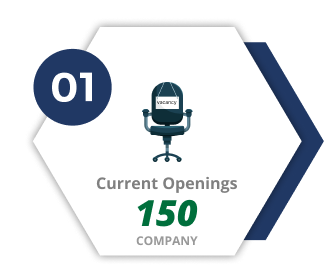Pay Only 75% Fee remaining 25% after Placement!
BECOME AN EXPERT IN FPGA DESIGN in ahmedabad
FPGA (field-programmable gate array) design involves the use of hardware components to create digital circuits and systems. It is typically used in applications such as image-processing, AI, and embedded systems. Through FPGA design, engineers can take advantage of the flexibility and scalability offered by this type of logic technology. With an FPGA-based approach to system design, engineers can quickly reconfigure a system for different types of tasks, making it ideal for applications that require rapid reconfiguration and high performance



Next Upcoming Training Batches

ELIGIBILITY
- Any year BTech, MTech, BE, ME pass out students
- with minimum of 50% in academics are eligible for.

Total fee: 1,00,000/-
- Student need to pay 50,000 in Training Period
- 10,000/- for registration immediately
- 10,000/- after the 1st month
- 10,000/- after the 2nd month
- 10,000/- after the 3rd month
- 10,000/- after the 4th month
- Remaining 50,000 after getting placement ( after receiving offer letter from company)
- * Gst applicable

Course Curriculum
- Semiconductor ecosystem
- VLSI design cycle - front end design flow & backend design flow
- What is ASIC & FPGA
- FPGA design flow & ASIC design and verification flow
- SoC example and industry updates
- Opportunities for VLSI engineers in India
- VLSI industry work profiles and roles
- How to be industry ready?
- Digital system design & applications
- Introduction
- What is digital & analog
- Introduction to digital system design
- Elements of digital logic, number system
- Code conversion, logic gates, K-maps, Boolean algebra, SOP, POS
- BCD, excess-3, gray code, ASCII, complements
- Combinational logic design: adders, subtractors, multipliers, dividers, comparators, multiplexing, demultiplexing, encoders, decoders, parity, checkers, data path, control path, ALU
- Sequential logic design: synchronous logic design, asynchronous logic design
- Latches
- Flip-flops
- Counters (asynchronous, synchronous, mod, Johnson, ring)
- Registers (SISO, SIPO, PISO, PIPO, USR, LFSR)
- FSM (Mealy and Moore – overlapping and non-overlapping)
- FIFO (asynchronous, synchronous)
- Memories (RAM, ROM)
- Introduction & Importance of HDL - HDL vs High Level Languages.
- Basic Language elements
- Design Methodologies - Top Down, Bottom Up
- Verilog data types
- Verilog Modelling Styles:
- Dataflow Modelling – continuous assignment statements
- Gate Level Modelling/Structural modelling
- Behavioural Modelling – Procedural blocks, procedural block statements – blocking and non-blocking assignments.
- Switch Level Modelling – switch primitives
- System Tasks
- Logic Gates, Half Adder, Full Adder, Half subtractor, Full subtractor.
- Multiplexer – 2:1, 4:1, 8:1 and other mux-oriented problems.
- Logic gates using Mux, Encoder, Decoder, Priority Encoder
- Stratified Event Queue or Timing Regions In-depth explanation with examples.
- Comparator, Seven Segment, Multipliers
- Combinational Circuits to be taught in Behavioral (IF, CASE) and Gate level
- Adders – RCA, Carry Look ahead adder, ALU, Subtractor, Division Circuits
- Sequential Circuits:
- Latch – Definition, usage, types, Coding and Simulation Result Explanation.
- Flipflop – Types (dff, tff, jkff), Coding and Simulation Result Explanation, Sync and Async FF. Difference between Latch and Flipflop, Why Nonblocking should be used for Sequential Circuits?
- Counter - Both Synchronous and Asynchronous, Mod Counters, Repeated Counters, Ring, Johnson Counters.
- FSM – Melay and Moore, Timescale, Parameter, Local Param, ifdef
- Shift registers – SISO,PISO,PIPO,PISO, Bi-directional Registers, Universal Shift Registers
- MEMORIES – RAM, ROM, Frequency Dividers, Self-checking testbenches.
- Define, setup, hold time, Types of delays to be used in coding. – Inter,Intra,Gate
- Sequential and Parallel execution blocks, generate blocks, Primitives - Try
- Randomization based testbenches, Task oriented TB.
- Synthesizable vs Non-Synthesizable Constructs explanation with examples, Loops.
- Race conditions in Verilog with Live examples
- ASIC Verification:
- Introduction & Importance
- Verification Methodologies
- System Verilog: Introduction to Verification and System Verilog.
- Data Types:
- Integer, Void
- String, Event
- User-defined Enumerations
- Class Arrays
- Fixed Size Arrays - Packed and Un-Packed
- Dynamic Array - Associative Array, Queues, structure, Union, typedef
- Procedural Statements and Flow Control:
- always_ff, always_comb, Blocking & Non-Blocking assignments
- Unique-I, Priority-If
- While, do-while, for each & enhanced for loop
- Repeat, Forever
- Break & Continue
- Named Blocks and Statement Labels
- Disable block and disable statements
- Event Control.
- Tasks and Functions:
- Tasks
- Functions
- Argument passing – Automatic, Static
- Processes:
- fork-join
- fork-join any
- fork-join none
- wait-fork
- disable-fork
- Classes:
- Classes
- This Keyword
- Constructors
- Static Class Properties & Methods
- Class Assignment
- Shallow Copy & Deep Copy
- Parameterized Classes
- Inheritance
- Overriding Class Members
- Super Keyword
- Polymorphism, Casting
- Data Hiding and Encapsulation
- Abstract Classes & Virtual Methods
- Class Scope Resolution Operator
- Extern methods
- Type def Classes.
- Randomization & Constraints:
- Constraint Blocks
- External Constraint Blocks
- Inheritance
- Inside operator
- Weighted distribution
- Implication and if-else and other constructs.
- IPCSemaphore - Mailbox - Event:
- Scheduling Semantics
- Program Block
- Interface
- Mod port
- Clocking Blocks.
- Assertion:
- Assertions
- SVA Building Blocks
- SVA Sequence
- Implication Operator
- Repetition Operator
- SVA Built in Methods
- Ended and Disable iff.
- Coverage:
- Coverage
- Functional Coverage – Types
- Coverage Options - Parameters and define.
- Project on System Verilog on Industry Standard Protocol with assertions and coverage along with tool explanation.
- INTRODUCTION
- UVM stands for Universal Verification Methodology.
- It is a standardized methodology for the creation of modular, reusable testbench components for verifying System-on-Chip (SoC) designs.
- The UVM methodology is based on the IEEE 1800 SystemVerilog standard and uses object-oriented programming principles for creating testbenches.
- The UVM methodology provides a structured, efficient and effective way to create reusable and scalable testbenches for complex SoC designs.
- UVM Testbench Architecture
- The UVM testbench architecture is made up of a hierarchical structure of components.
- The top-level component is the UVM Test, which manages the overall simulation process.
- The UVM Top component is responsible for setting up the simulation environment and connecting the different components of the testbench.
- The UVM Agent is responsible for interfacing with the design-under-test (DUT).
- The UVM Scoreboard verifies the correctness of the DUT outputs against the expected results.
- The UVM Sequencer generates and manages the flow of stimulus to the DUT.
- The UVM Driver converts the stimulus generated by the sequencer into signals that can be applied to the DUT.
- The UVM Monitor monitors the signals at the DUT interface and converts them into transactions that can be checked by the scoreboard.
- UVM Phases
- The UVM methodology defines several phases that define the different stages of the simulation process.
- The different phases include build, connect, end-of-elaboration, start-of-simulation, run, and shutdown.
- Each phase has a set of associated callbacks that allow users to customize the behavior of the simulation at different stages.
- UVM TLM
- The UVM methodology provides support for transaction-level modeling (TLM).
- The Analysis Port is a TLM interface that allows different components of the testbench to communicate with each other using transactions.
- The UVM methodology defines several different types of TLM ports, including analysis ports, analysis export, and analysis imp.
- The UVM TLM protocol provides a standardized way of defining and connecting TLM ports between different components of the testbench.
- Register Layer
- The UVM methodology provides a standardized way of modeling and testing register-based designs.
- The Register Model defines the register and field definitions for the DUT.
- The Register Environment is responsible for managing the configuration and operation of the registers.
- The UVM methodology provides support for connecting the register environment to the DUT and for testing the register operations using the scoreboard.
- UVM Reporting
- The UVM methodology provides a powerful reporting mechanism for debugging and analyzing simulation results.
- The reporting mechanism includes configurable verbosity levels and a standardized message format.
- The UVM methodology also provides support for defining and reporting user-defined messages.
- UVM Configurations - Macros Explanation in UVM.
- UVM Factory – Registration - Factory Methods Explanation.
- UVM Callback - Body Call back - Usage and Importance of Call Backs.
- Lock Grab - Examples Arbitration - Importance of Arbitration - Usage of Arbitration - Sequencer Arbitration. Virtual Sequence, Sequencer - Need and Usage of Virtual Sequence and Sequencer.
- Sequential and Parallel Sequence, Layered Sequences- Overview and Implementation of Sequences.
- UVM MACROS - Macros Explanation in UVM.
- UVM Project – UVC Development for Industry standard protocol.
- Explanation of IP, VIP, SOC Level Testbench flow, Testplans, Verification plan.
VLSI FIRST Vs OTHERS
| Key Considerations | VLSI First | Other INSTITUTE |
|---|---|---|
| Course Fee |
|
|
| Trainers |
|
|
| Placement |
|
|
| Class size |
|
|
| Course module |
|
|
| Projects |
|
|
| Locations |
|
|
| Assessment |
|
|
Why VLSI FIRST ?

Smaller class size - only 20 students per batch
VLSI Training with low student to teacher ratio has many advantages like one to one attention, students get an increased opportunity to bond with trainers, chance to trailer individual learning and less disruption.
Course Modules
We always listen to our students and Industry, and develop courses that meet the current demands of industry through a wide range of industry contacts and innovative teaching methods. These VLSI training modules are designed by our industry experts and are customized as per the requisites of the Semiconductor organizations


Exclusive, Experienced and Industry Professionals as Trainers
VLSI FIRST possesses a team of Exclusive trainers and industry professionals who have gained years of experience working on live project development and implementations. Their passion for study, learner-focused approach and their industry expertise gives learners an inspirational learning experience and an understanding of industry trends. Along with the exceptional academic faculties, our institute also possesses a strong team of administration staff, who ensure that your education sessions run smoothly and you get all the things that you need for VLSI Training conveniently.
Projects
RTL Design and Verification Training Projects are on Latest Industry Applications and Trends, Every student gets a different project, once student finishes his project before time then he can involve in other project, projects implementation helps understand VLSI technology and useful in getting placement.


Fee
Pay 25% fee after Placement, Quality Education at affordable price
Placement Assistance
Placement Training Starts from 1st day of Training and Placement Assistance will be valid upto 1 year after Training, for more details see placements page VLSI Training RTL Design and Verification Training


100% Placement Assistance
The Placement Cell of "VLSI FIRST" provides guidance and all the assistance to the students in order to achieve their career goals.
JOB ROLES
RTL Design Engineer
ASIC VERIFICATION Engineer
DV Engineer
Project Manager
Automotive Embedded
FPGA DESIGN Engineer
Test Engineer
Applications Engineer
PreSilicon and Post Silicon Validation Engineer
Frequently Asked Questions
Total fee: 1,00,000/- (+GST) Student need to pay 50,000 in Training Period
10000/- for Registration
10000/- after 1 st Month
10000/- after 2 nd Month
10000/- after 3 rd Month
10000/- after 4 th Month
Remaining 50,000 after getting placement (after receiving offer letter from company)
Total fee: 80,000/- (+GST) Student need to pay 40,000 in Training Period
10000/- for Registration
10000/- after 1st Month
10000/- after 2nd Month
10000/- after 3rd Month
Remaining 40,000 after getting placement (after receiving offer letter from company)
7pm to 8pm Lab session (we can change based on students availability between 6pm to 9pm for 1hr)
same timings from Monday to Friday, on Saturday we conduct Test and Sunday Holiday
1) Product Companies Ex: Intel, AMD, Qualcomm etc..
2) Service Companies Ex: Wipro, Capgemini, L&T etc...
For the total list of companies please go to our placement page.
Placement Process:
After 6 Months of Training, we provide 1 week of Placement training which includes your
- Resume preparation,
- Interview Questions Preparation,
- Technical Interview Preparation and
- HR Interview preparation.
MNC companies will be coming for 2months, we make sure that all the students get placed in MNC companies.
Those who are not successful in getting placement in MNC's will be attending start-ups for next 2 months.
If in worst case any student is not successful in getting placement in start-ups also, then we send them for internship in our company for next 3 months.
In internship students will be working directly on clients’ projects and will gain experience. Once students are done with internship then we take interview and based on students’ performance we give them 1 year of Internship experience as they have spent 1 year in institute (6 months for training + 2 months for MNC placements + 2 months for start-up placements + 3 months for internship = 12months)
Advantages if going as experienced candidate:
- More Opportunities – more openings in companies for experienced candidates
- Good Salary package
- Simple interview process (No written test and mostly 2 rounds of Interview)
- No bond and we can choose location of work.

FPGA Design Training in ahmedabad
If you're looking for comprehensive and top-quality FPGA design training in Ahmedabad, you've come to the right place. Our FPGA design course in Ahmedabad is designed to provide students with the skills and knowledge they need to succeed in this dynamic and exciting field. Whether you're a seasoned professional or just starting out, our FPGA design certification in Ahmedabad is the perfect way to enhance your skills and increase your job prospects.
FPGA design bootcamp in Ahmedabad is designed to be intensive and immersive, providing students with hands-on experience and real-world applications. With the guidance of our experienced instructors, you'll learn the fundamentals of FPGA design, including programming languages and design methodologies. You'll also gain experience with FPGA development tools and simulation software, allowing you to create complex designs with ease.
Our FPGA design coaching in Ahmedabad is tailored to the needs of each student, with personalized instruction and support throughout the training process. Our instructors are experts in the field of FPGA design, with years of experience working in industry and academia. They'll work with you to develop your skills and knowledge, answering your questions and providing feedback every step of the way.
At our FPGA design institute in Ahmedabad, we believe that learning should be flexible and accessible. That's why we offer FPGA design online in Ahmedabad, allowing you to learn from the comfort of your own home. Our online courses are designed to be engaging and interactive, with live instruction and real-time feedback from our instructors. You'll also have access to a wealth of resources, including video tutorials, code examples, and interactive exercises. No matter what your learning style or schedule, our FPGA design class in Ahmedabad is the perfect way to gain the skills and knowledge you need to succeed in this exciting field. So why wait? Enroll in our FPGA design training today and start your journey to becoming an expert in FPGA design!









